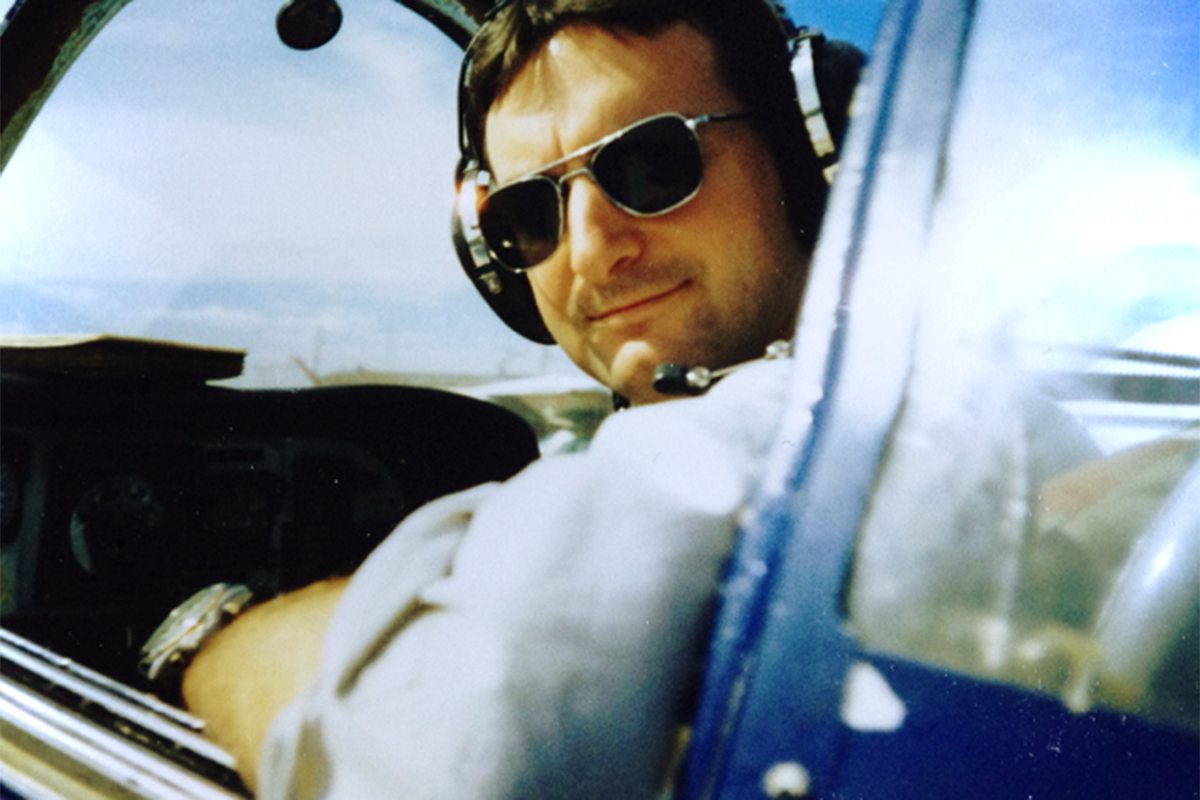Good FLYING Reads: Red Burning Sky
A novel reveals the story about a little-known C-47 rescue operation during World War II in Yugoslavia.

Tom Young gets ready in the only warbird he’s ever flown—a T-34 Mentor at the Quantico Flying Club in the 1990s. [Courtesy: Tom Young]
It’s a stunning story. A disparate collection of 100—no, 300—no 500 downed airmen hidden in and around a town in rural Yugoslavia during the ragged last year of World War II are rescued by secret airlift. And for the bravery and courage of both the local Serbian people and the pilots and crew that flew in to airlift the Allied soldiers out, there were no medals, no recognition until many years later.
Tom Young’s Red Burning Sky kept me engaged—and didn’t hit any off notes as far as aircraft operations, a nod to his thorough research.
I had to ask Young—a former member of the U.S. Office of Strategic Services (OSS) and a flight engineer with 5,000 hours in the seat for the Air National Guard—how he came to the story and what informed his prose so well.
The operational realism portrayed of the Douglas C-47 is of particular note—did you get a chance to fly in one at all during your research, or interview pilots who have?
Unfortunately, I haven’t had a chance to fly a C-47, though I hope to correct that situation at some point in the future. But I did the next best thing: On YouTube, of all places, I found a terrific C-47 training film from World War II. The film walks the viewer through every phase of flying the C-47, from preflight to shutdown. Someone—perhaps several someones—has done writers and historians a great favor by uploading to YouTube all kinds of WWII training films. You can find one on nearly anything: how to clean an M1 rifle, how to pack a WWII parachute, how to operate the field radios of that day, et cetera.
These films are as good as any training film I saw in the military, except of course these are black and white. Back then, the War Department mustered A-list Hollywood talent to write, direct, and appear in these films. The actor Arthur Kennedy plays the instructor pilot in the C-47 film, and you really believe him in his role as an experienced instructor. In his civilian career, he went on to win a Tony Award and a Golden Globe Award, along with several Oscar nominations.
I also spoke with pilots who’ve flown the C-47. I cold-called the World War II Airborne Demonstration Team, based in Frederick, Oklahoma. That’s a wonderful living history organization. As their name implies, they fly personnel drops in period uniforms to demonstrate how airborne troops got into the fight during WWII. Their mission is to honor veterans and to educate the public about that part of our history. When I spoke with them, those folks were terrific. They answered all my questions and even emailed me a PDF of a WWII-era C-47 pilot’s manual, which was quite helpful.
Are there any resources you found particularly valuable for understanding more about the airlift/rescue operations like Halyard that took place during World War II and other conflicts? Where could readers go for more?
I had two primary historical resources: One was a nonfiction book about Operation Halyard, The Forgotten 500, by Gregory A. Freeman. The other was the Halyard Mission Foundation, a joint Serbian-American nonprofit group dedicated to keeping alive the memory of Halyard. The group does historical research, sets up historical markers, honors veterans and their families with recognition plaques, and even provides educational stipends for kids in the village that sheltered downed American airmen so long ago.
For more information, readers could go to any of several books that have been written about the U.S. Office of Strategic Services, or OSS. That agency was a forerunner of the CIA, and its officers helped coordinate Operation Halyard and many other highly risky WWII operations. The courage and creativity of OSS members is quite an inspiring story.
Of the characters in the book, with whom did you identify most?
I identified most closely with Vasa, the teenage guerrilla fighter who helps with the rescue operation. As I mentioned in the novel’s historical notes, that character was inspired by one of my professors at the University of North Carolina at Chapel Hill. As a very young man, Dr. Vasa Mihailovich took up arms when Yugoslavia was fighting a civil war in the midst of a world war. After the war, he spent five years in refugee camps and eventually made his way to the United States. He paid for his education by working on a Chrysler assembly line, and he became a respected scholar of Eastern European languages and literature. I don’t think he was a soldier by nature. I imagine his happy place was sitting by the fire with a good book. But in his youth, he picked up a weapon and did what he had to do regardless of the cost, and you really have to respect that.
What's the next project? What's inspiring your writing further?
The next project will probably be another World War II story. I haven’t settled on a plot yet, but I’ve been reading about the French Resistance and the air operations that supported them. For example, the British Royal Air Force used the Westland Lysander, a single-engine liaison aircraft, to supply Resistance teams and to bring agents in and out of occupied France. Very dangerous stuff, flown VFR at night. Those pilots must have had more guts than sense.

Subscribe to Our Newsletter
Get the latest FLYING stories delivered directly to your inbox






